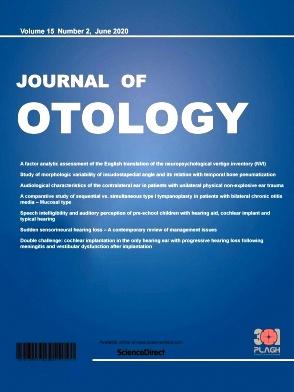Primary and revision myringoplasty in children: Long-term outcome and analysis of the factors influencing the results
IF 1.4
Q2 OTORHINOLARYNGOLOGY
引用次数: 0
Abstract
Objective
Assess the long-term outcome of pediatric myringoplasty.
Methods
Tympanoplasty type I, myringoplasty, was performed on 85 children (91 consecutive operations, 74 primary and 17 revisions) under 16 years of age. The perforations were sequela either to acute or chronic inflammatory middle ear disease. Medial grafting technique was employed with temporalis fascia. Adenoidectomy was performed earlier on all but five children. The preoperative observation period exceeded one year for all patients. The mean follow-up was 5.4 (SD 3.6) years.
Results
The long-term graft take rate was 84% for primary myringoplasty, and 53% for revision operations. The re-perforations were associated with postoperative discharge, subtotal or total perforation and revision surgery. In the cohort, sixty ears (66%) were completely healthy (intact tympanic membrane in normal position without adhesions and with good mobility) after follow-up. Spontaneous healing took place in 37% after re-perforation. The preoperative ventilation tube treatment did not affect the outcome and there were no differences between age groups. Preoperative sonotubometry or Valsalva test results did not correlate with outcome. Four ears needed a ventilation tube during the follow-up due to poor ventilation. The mean pure tone thresholds improved significantly after operation.
Conclusions
Myringoplasty in children is a reliable procedure without age restrictions. One year of preoperative observation excludes most unstable ears, and high tendency of spontaneous healing after re-perforation suggests the need for a lengthy follow-up before revision surgery.
儿童原发性和改良性鼓膜成形术的远期疗效及影响结果的因素分析
目的评价小儿鼓膜成形术的远期疗效。方法对85例16岁以下儿童行ⅰ型鼓膜成形术,其中91例为连续手术,74例为初次手术,17例为改良手术。穿孔是急性或慢性炎症性中耳疾病的后遗症。颞筋膜内侧植骨术。除5名儿童外,其余儿童均行腺样体切除术。所有患者术前观察期均超过1年。平均随访时间5.4年(SD 3.6年)。结果原发性鼓膜成形术远期植皮率为84%,翻修手术远期植皮率为53%。再穿孔与术后出院、小穿孔或全穿孔以及翻修手术有关。随访后,60耳(66%)完全健康(鼓膜完好,位置正常,无粘连,活动能力良好)。再穿孔后自发愈合率为37%。术前通气管处理对预后无影响,年龄组间无差异。术前超声测量或Valsalva试验结果与预后无关。随访时4耳通气不良,需置通气管。术后平均纯音阈值明显提高。结论儿童羊膜成形术是一种无年龄限制的可靠手术方法。术前一年的观察排除了大多数不稳定耳,再穿孔后自发愈合的高倾向表明需要在翻修手术前进行长时间的随访。
本文章由计算机程序翻译,如有差异,请以英文原文为准。
求助全文
约1分钟内获得全文
求助全文
来源期刊

Journal of Otology
Medicine-Otorhinolaryngology
CiteScore
2.70
自引率
0.00%
发文量
461
审稿时长
18 days
期刊介绍:
Journal of Otology is an open access, peer-reviewed journal that publishes research findings from disciplines related to both clinical and basic science aspects of auditory and vestibular system and diseases of the ear. This journal welcomes submissions describing original experimental research that may improve our understanding of the mechanisms underlying problems of basic or clinical significance and treatment of patients with disorders of the auditory and vestibular systems. In addition to original papers the journal also offers invited review articles on current topics written by leading experts in the field. The journal is of primary importance for all scientists and practitioners interested in audiology, otology and neurotology, auditory neurosciences and related disciplines. Journal of Otology welcomes contributions from scholars in all countries and regions across the world.
 求助内容:
求助内容: 应助结果提醒方式:
应助结果提醒方式:


